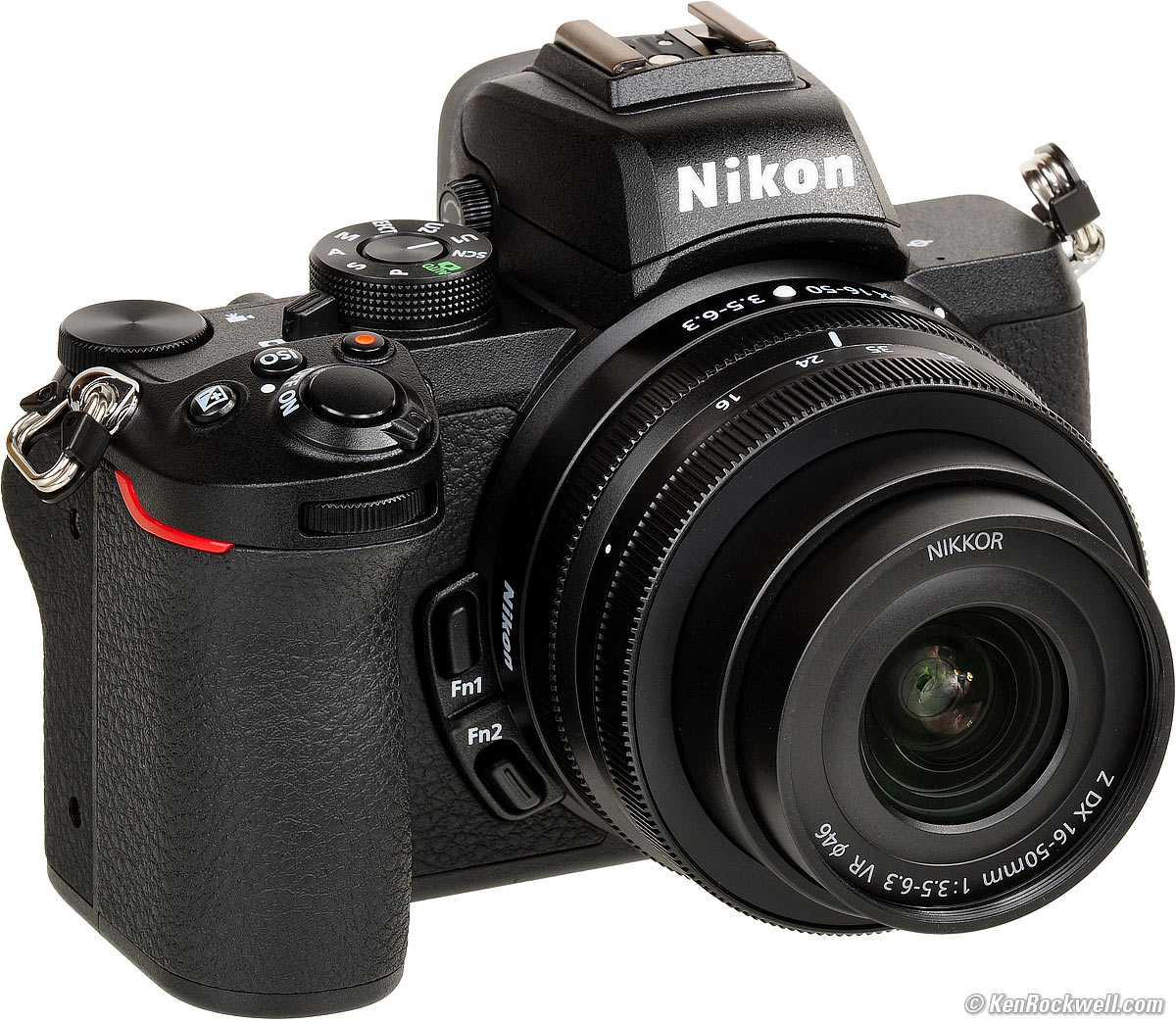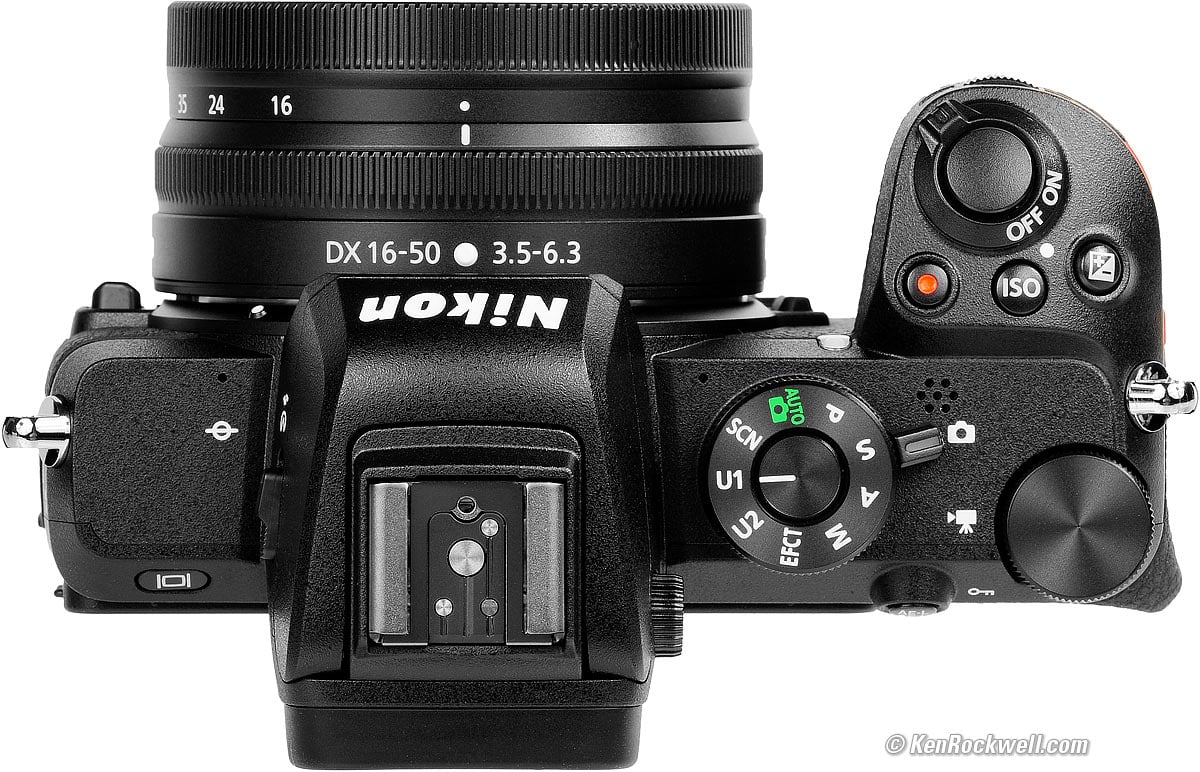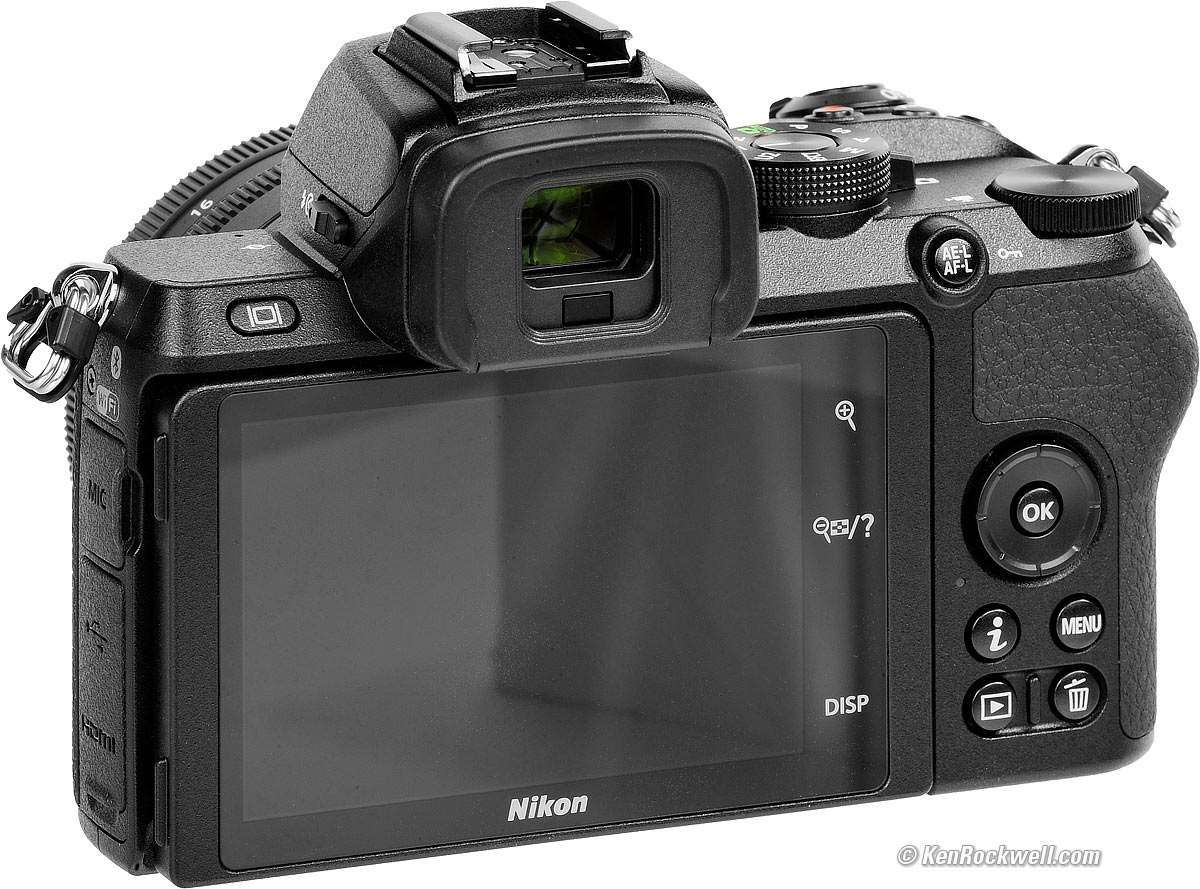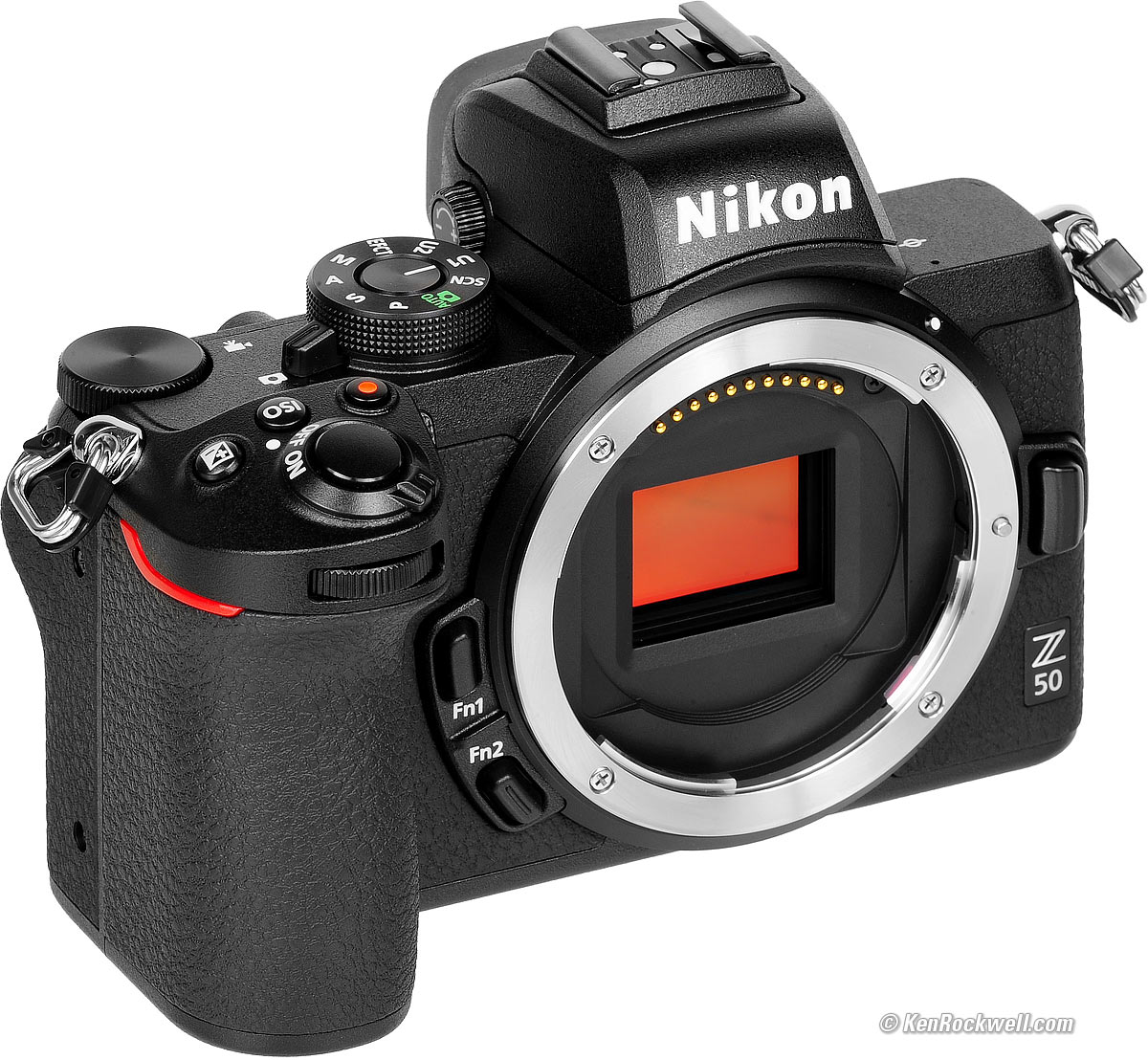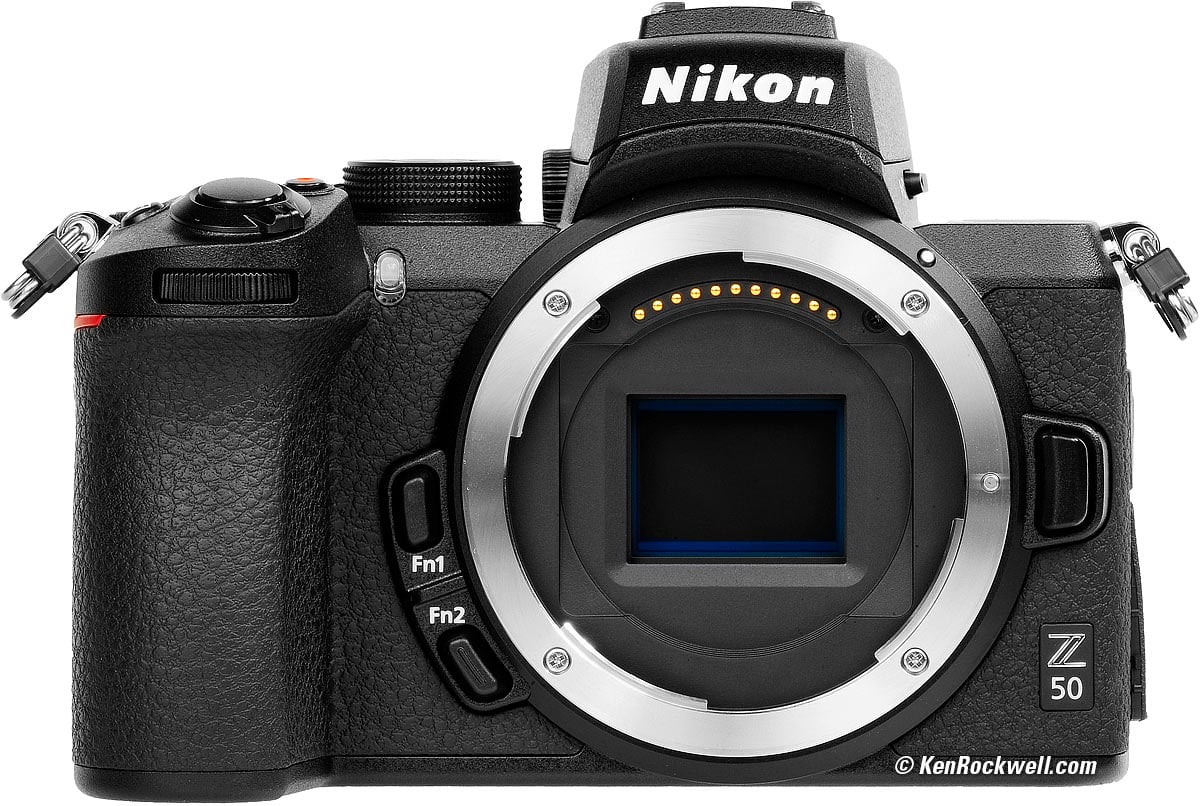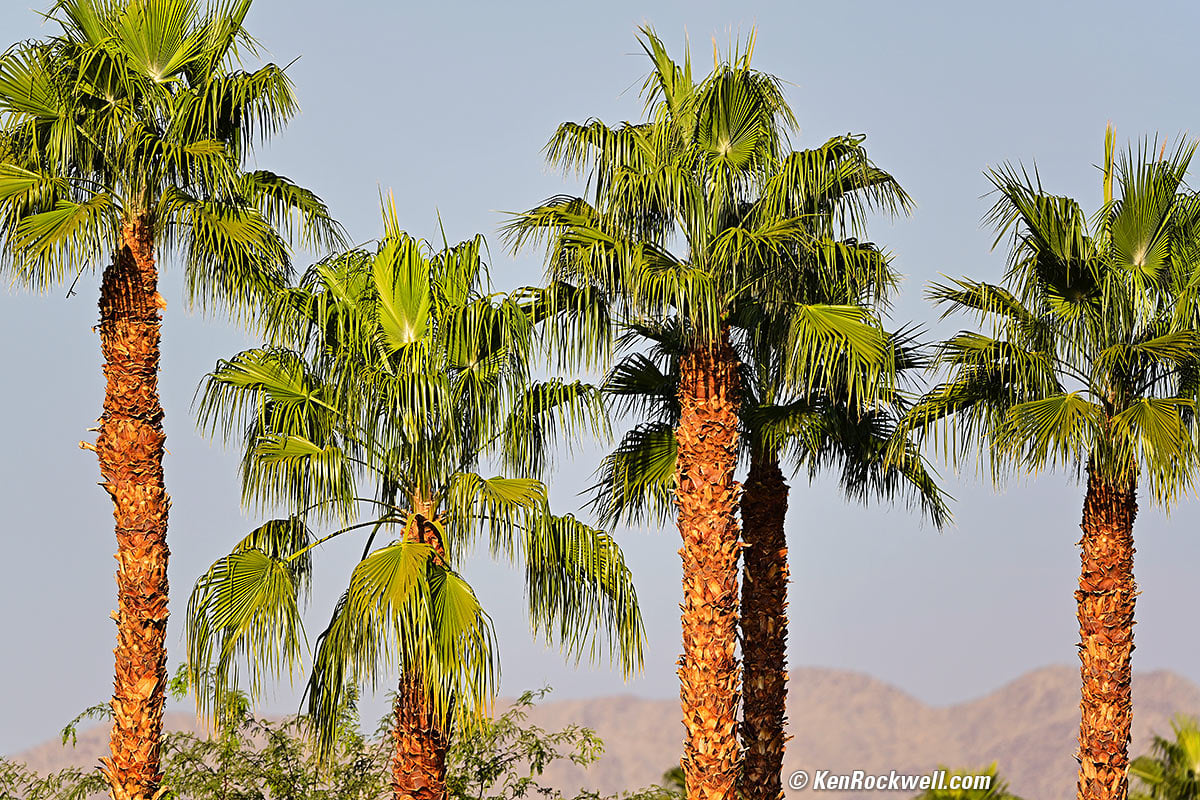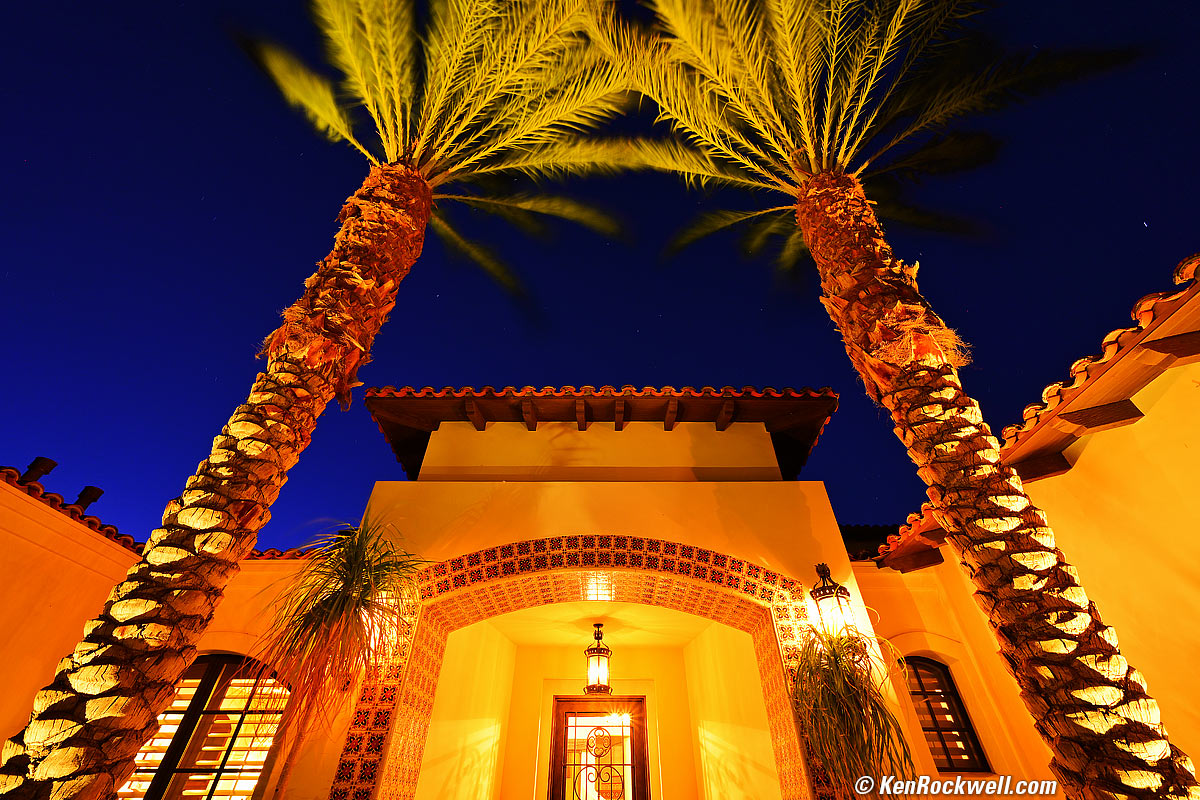Nikon Z50 User's Guide
<— back to Nikon Z50 Review
Viewfinder Monitor Control Button Fn Buttons
Autofocus AF Tracking Rear-Button Focus
Shooting Silent Mode Bracketing
Electronic First-Curtain Shutter
Metering Square & 16:9 Crop Modes
Flash Studio Strobes & Flash-Only Shots
Self-Timer Time Exposures Movies
Z9 Z8 Z7 II Z6 II Zf Z7 Z6 Z5 Z fc Z50 Z30
Z System Z Lenses All Nikon Lenses Flash
Nikon Z50 (15.7 oz./446g with battery and card, $857) and Nikon Z 16-50mm DX VR. bigger or fill screen. I got mine at B&H. I'd also get it at Adorama, at Amazon or at Crutchfield. It comes as many different kits at B&H (I actually got the kit with both the 16-50mm and 50-250mm lenses), at Adorama, at Amazon and at Crutchfield.
This 100% all-content, junk-free website's biggest source of support is when you use those or any of these links to my personally-approved sources when you get anything, regardless of the country in which you live. Nikon does not seal its boxes in any way, so never buy at retail or any other source not on my personally approved list since you'll have no way of knowing if you're missing accessories, getting a defective, damaged, returned, non-USA, store demo or used camera. Get yours only from the approved sources I use myself for the best prices, service, return policies and selection. Thanks for helping me help you! Ken.
November 2019 Nikon Mirrorless Mirrorless Lenses All Nikon Lenses Nikon Flash All Reviews
Nikon Z50 and Nikon Z 16-50mm DX VR. bigger or fill-screen.
Nikon Z50 and Nikon Z 16-50mm DX VR. bigger or fill-screen.
Nikon Z50. bigger or fill-screen.
|
I buy only from these approved sources. I can't vouch for ads below. |
Battery Charging
Plug the camera into any USB outlet with any generic micro USB cord and leave it turned off. (It won't charge with the power switch turned on.)
You may see a tiny orange CHARGE LED below the USB socket, which goes out when done. I leave my Z50 upside down when charging so I can watch for the LED better.
You can use the included external MH-32 Battery Charger, but I'd only bother if I had two batteries to charge at once (one in-camera via USB and one in the external charger.)
Nikon rates this charger for a full charge in 2.5 hours, and says you'll get a full charge in 3.5 hours over USB.
Power Conservation
Nikon is tops here: you can leave your Nikon Z50 ON and it's always ready to shoot with a second's notice.
It goes to sleep and wakes automatically. Of course it does take a second to wake up so you need to remember to tap the shutter as you're bringing the camera to your eye, and otherwise it sleeps properly as you carry it around all day shooting.
Viewfinder
Hit DISP to the right of the LCD to see the 3D level or histogram displays as you shoot.
Monitor Control Button
The Nikon Z50 has automatic EVF/LCD switching, so what does the little "|▢|" button on the top left rear side of the camera do? It lets you control when or if the rear LCD lights.
By default, the "Automatic display switch" setting magically turns-on the finder or the rear LCD depending on whether or not your eye is on the finder. Leave it set here.
Press the "|▢|" button once and it turns off the rear LCD, even if you hit PLAY or MENU! You will think your camera is broken, since set like this the finder only activates with your eye on it and the LCD is always off even if you hit PLAY or MENU. Use this setting if you're a deployed sniper or otherwise don't want the rear LCD turning on and giving away your position.
Press the "|▢|" button again and "Monitor only" mode deactivates the finder. Only the rear LCD works no matter what you do.
Press the "|▢|" button a third time and, whew, you're back to the normal "Automatic display switch" setting. I'd like to deactivate or reprogram this button to do something else, but tough, it never gets hit by accident over on the left — but remember it's there in case your LCD or finder ever don't work.
Programing Fn Buttons
Fn1 and Fn2 Buttons. bigger or fill-screen.
We can program what the Fn1, Fn2 and other buttons do.
Assign these at MENU > CUSTOM SETTING MENU (pencil icon) > f Controls > f2 Custom controls (shooting).
I set my Fn1 button to Focus mode/AF-area mode and my Fn2 button to Choose Image Area, and you may do whatever you like.
Lenses
The Nikon Z50 uses a brand-new Nikon Z mount optimized for Nikon's new Z-mount mirrorless S lenses.
Right now there are only two Z lenses optimized for the DX format, which are the 16-50mm and 50-250mm. Both are excellent.
You should get the 16-50mm, and get the 50-250mm if you need a telephoto. Done.
I would not recommend the FTZ adapter; other lenses you might already own might work, but the FTZ alone weighs more than the 16-50mm, and no adapted lens will work as well on the Nikon Z50 as the 16-50mm and 50-250mm do.
Manual-focus F, AI , AI'd, AI-s and adapted rangefinder lenses works poorly on the FTZ with no automatic diaphragm control, poor exposure control, poor finder brightness control and no EXIF or in-finder aperture data — and you have to open-and-close the diaphragm manually for precise focus for each shot!
The Fringer EF-NZ Adapter adapts Canon EF lenses with often better results on my Nikon Z cameras than Nikon's own lenses give on the crappy FTZ adapter! It also works with other brands of lenses in Canon EF mount, adapting them to Nikon Z.
Turning VR On and Off
Z lenses no longer have VR switches.
Instead, set this in the Z50 at MENU > PHOTO SHOOTING MENU (camera icon) > Optical VR > ON or OFF.
There's also a SPORT option, obviously for shooting sports.
Autofocus
Luckily the Nikon Z50 comes with the autofocus options preset to where you want them for the fastest and easiest shooting: AF-S and Auto AF-Area Select.
Autofocus is fast if you let it pick the AF sensors for a still image, or if you select just one AF area for something that moves, but it you want to let it pick the sensors and then let the Nikon Z50 try to track up/down/left/right all by itself, it's not that great. The Z50 isn't as good as a DSLR for sports and action.
While it's very fast for photos of things that hold still, a the Nikon Z50 (as well as the Z7 and Z6) can't keep up if you expect it to track focus in and out at the same time as you expect it to track objects moving left and right across multiple sensors.
I set my Fn1 button to let me set the AF system. There are two settings, which control things in different dimensions.
Once set, hold Fn1 and turn the rear dial to select among these settings. You'll probably see these indications in yellow along the top center right of your finder or rear LCD:
AF-A: Autofocus, Automatic control. Use this mode. In AF-A the Nikon Z50 figures out the best of the next two modes to use depending on what your subject is doing:
AF-S: Autofocus Single. AF-S means that the Nikon Z50 focuses once, and then locks the AF system. Use this for shooting things that don't move. This lets you focus and then recompose without having to twiddle anything. If your subject is holding still, the AF-A mode should also do this exactly the same.
AF-C: Autofocus Continuously. In AF-C the Nikon Z50 is always autofocusing, tracking whatever moves in and out. Use this for sports or action or wiggly kids. The AF-A mode also should do this magically if your subject is moving around.
M: Manual Focus. Again, the Nikon Z50 and new 16-50mm and 50-250mm lenses are so smart that even in an autofocus mode just turning a manual focus ring should shift the Nikon Z50 magically to manual focus and hold your setting. Set the M mode if you want to be sure nothing changes once you've focussed.
Once set, hold Fn1 and turn the front dial to control which autofocus areas (zones) are used, and how. You'll probably see these icons in yellow along the top center right of your finder or rear LCD:
[▆]: Select AF areas automatically. I use this; it lets the Nikon Z50 figure out where to focus all by itself. Only if it can't figure it out by itself do I select:
[□]: Use only one AF area. This lets me pick where the Nikon Z50 focuses. Use the big round rear selector to move the selection.
[+]: Use a set of five AF areas. I never use this. Try it if you like.
[WIDE-S]: Uses a small region of AF sensors. I never use this, try it if you like.
[WIDE-L]: Uses a larger region of AF sensors. I never use this, try it if you like.
The Nikon Z50 has a design flaw where RED AF BOXES sometimes mean GO!
In AF-S, single AF, it's fine: GREEN means LOCKED - GO and RED means UNLOCKED - STOP! Perfect.
The problem is in AF-C, continuous AF, where RED means IN FOCUS - GO and YELLOW means UNLOCKED, STOP!
In Continuous AF (AF-C) there are YELLOW boxes around found faces, and RED boxes around whatever's being tracked. In AF-C, red is good.
Good luck if you expect to use both AF modes: RED means GO in AF-C and GREEN means GO in AF-S. Good luck remembering which AF mode you're using so you can know if red or green means GO today.
There is a "Low Light AF" option at MENU > CUSTOM SETTING MENU (pencil icon) > a7 Low-light AF. I leave it ON. Ideally the camera should figure this all out itself.
Autofocus Tracking
While the Z50 should do this magically, it doesn't. This is why Sony is much better for tracking action; Sonys have the smarts to do this automatically.
You have to tell the Z50 very manually to assign, track and stay focused on one object as it moves all around.
To do this, set AF-C and All-Area AF [▆] as shown above, then tap the rear OK button. You'll see a gray square on the screen with four directional arrows.
Point the camera so that the box is over your subject (the hard way is to move it with the four-way rear controller), and then hold the shutter button halfway to start and keep autofocus running. The box will now stay on top of your subject and keep it in focus as it moves in and out, up and down and left and right. You can take pictures, or take your finger off the shutter and start again; the system keeps tracking your subject.
To grab another subject, tap OK to freeze the box, put it over the next subject, and half press the shutter again.
Tap the touch panel's (-)/? button to cancel this.
Rear-Button Autofocus
If you want to press a rear button to activate autofocus, rather than having it autofocus whenever you've half-pressed the shutter button, first deactivate the shutter button from autofocusing:
MENU > CUSTOM SETTING MENU (pencil icon) > a Autofocus > a4 AF activation > AF-ON only > OK.
Now assign the autofocus function to the button of your choosing. Most people would use the top rear AE-L/AF-L button, but hey, it's your camera:
MENU > CUSTOM SETTING MENU (pencil icon) > f Controls > f2 Custom controls (shooting) > (select a button) > OK > choose AF-ON > OK.
Shooting
I leave everything set to automatic, which gets me the sharpest pictures the fastest. The key is I set my camera very carefully in advance to have it make all my settings exactly as I would do manually, and then know what to force to manual if and only if I need to.
I don't use the AUTO position on the top dial because it locks-out many of the advanced settings I use. I set P on the top dial ("Program" or "Pro" exposure mode which selects aperture and shutter speed automatically) and leave everything else in auto: Autofocus, Automatic AF Area selection [▆], Auto ISO, Auto White Balance, Auto minimum shutter speed in Auto ISO, etc. I do this because I've taken the time to program my camera to set all these as I would do manually so I can concentrate on my picture and not my camera while I'm shooting. My camera can make all the ISO and exposure and focus adjustments faster than I can, once I've programmed the camera to do this itself.
I take a setting off auto only if it's not doing what I want it to do.
I never set a manual ISO. The only time I use manual ISO is in my studio under controlled lighting, or when I'm on a tripod when I'll set it to ISO 100.
Set your camera the way I do and you'll always get the sharpest pictures. 99% of the time when people ask me to diagnose their soft pictures it's because they set their camera manually — and set it wrong. Amateurs too often use too high an ISO, too high a shutter speed and too small a lens aperture, all three of which lead to softer pictures:
1.) ISO 100 is sharpest. As in all modern cameras, each higher ISO gets softer due to noise reduction.
2.) Apertures smaller than f/8 dull the image due to diffraction unless you really need more depth-of-field; and you won't need that much depth of field if you set up your shot properly. Don't use f/16 or f/22 unless you really need it.
3.) Higher shutter speeds require you use a higher ISO, which makes the image softer. 1/500 to 1/1,000 stops sports and easily freezes fast-moving water. 1/125 stops people in anything other than sports. Don't use 1/2,000 or higher unless you really, really need to or have enough light to be shooting at ISO 100 — or need it to shoot at very large apertures at ISO 100 in daylight.
Shoot with the all-auto settings I use and the Nikon Z50 does all this all by itself with no need to change any settings from shot to shot. The Nikon Z50 will shoot at the optimum ISO and shutter speed and aperture under every condition from daylight to moonlight for photos of things (U1) or photos of people (U2). Easy! More at U1 and U2.
HINT: Mirrorless cameras can take a second to turn on or wake from sleep, which can seem like a long time if you don't tap the shutter until you have already brought your camera to your eye while walking around at an event. No worries, I make a point of tapping the shutter to wake my Nikon Z50 every time before I bring it to my eye and thus it's always ready to go. For the first time in 15 years since we all went DSLRs we now have to learn new tricks with completely different kinds of cameras, and this is one of them.
Silent Shooting
Set this at the last item at MENU > PHOTO SHOOTING MENU (camera icon) > Silent photography > ON.
Like all cameras, you can't use flash, flicker reduction or HDR while in silent mode, and like all cameras other than the Sony A9 you can expect some occasional weird effects under flickering light or with objects moving across the frame due to the rolling shutter.
The ISO range in Silent is limited to ISO 51,200 maximum. There's no limit to the minimum, shoot at ISO 100 if you like, but for ISO 102,400 (Hi1.0) or 204,800 (Hi2.0) you'll have to use the regular shutter.
Silent modes works at all frame rates and exposure times from 1/4,000 down to minutes in TIME exposures.
Bracketing
Z cameras no longer have BKT buttons for setting exposure bracketing.
Better, they offer your choice of Exposure, White Balance or Adaptive Dynamic Range bracketing.
Set this at MENU > PHOTO SHOOTING MENU (camera icon) > Auto bracketing > and choose which kind of bracketing you want.
By default, Number of Shots is 0 Frames, meaning no bracketing. To activate bracketing, set Number of Frames to anything other than 0.
If you do this a lot, program one of your function buttons to this feature.
Electronic First-Curtain Shutter
In addition to the regular mechanical and silent electronic shutter options there is a third "Electronic First Curtain" option at MENU > CUSTOM SETTING MENU (pencil icon) > d Shooting/display > d4 Shutter type.
This means the shutter opens silently, and makes a mechanical click when it closes. This is great for eliminating camera shake on a tripod, and lets you know when your exposure is done.
Light Metering
Leave it set to MATRIX.
Press the rear 𝒊 button, select the bottom row and then the third box from the left, and it should be at Matrix metering.
The Center-weighted and Spot modes are obsolete static modes from the 1970s. Nikon leaves them in to satiate old-tymers, and the only time I see people with exposure problems is when someone actually uses these old modes, but doesn't know and apply the Zone System which is required to use these properly, as we did in the 1970s.
The Highlight priority mode is an idea if you intend to twiddle with your images on a computer later; this mode prevents anything from overexposing, but can lead to overly dark images that need to be cleverly lightened with software like Perfectly Clear later for optimum results.
Matrix usually gets everything right, and if your images are too dark or light, press the top +/- (exposure compensation) button, click the rear dial left or right a click or two and you should be able to get perfect exposure.
Square & 16:9 Crop Modes
It's easy to set the Nikon Z50 to shoot square photos, which I find very useful for people shots as I never miss anything while rotating my camera between vertical and horizontal. Square shots are also great for submission to photo editors as this lets them pick whatever crop fits their layout, increasing your chances of a sale.
16:9 mode isn't very useful unless you're shooting stills to edit into video.
You set these at MENU > PHOTO SHOOTING MENU (camera icon) > Chose image area.
I find this mode so helpful I set one of my Fn buttons to let me select the crop mode.
Flash
The Nikon Z50's built-in flash is probably all you need. I don't use it indoors or at night, but use it most of the time in harsh lighting outdoors and photographing people in direct sunlight for fill-flash.
I almost never use flash at night. If I do, I gel (filter) the flash with an orange (CTO) gel filter to match tungsten or green to match fluorescent lighting.
If you want more power or faster recycling for hard shooting, the Nikon SB-400 is the ultimate mirrorless flash. It works flawlessly with the Nikon Z50, even turning on and off with the Nikon Z50's power switch.
Even more than it was on DSLRs, it's tiny as you want on mirrorless, and it's powerful and recycles fast and the Nikon Z50 balances it for fill perfectly.
The SB-400 was discontinued; no worry, you can get them on eBay for under $100 (see How to Win at eBay).
The SB-400 is much better for mirrorless than today's bigger, crummier and more expensive SB-300 and SB-500. The SB300 is bigger, junkier, lower powered and takes too long to recycle from it's pathetic AAA cells, and the SB500 is too darn big and costs more than twice as much for about the same performance as the tiny SB400.
Of course the Nikon Z50 works with the larger and excellent SB-700 and SB-5000, just that they are bigger than the camera and you probably don't need all that power. The SB-400 has more than enough power and fits the camera's size better.
Studio Strobes & Flash-Only Exposures
By default the Nikon Z50 shows you the effects of your exposure and picture control settings (contrast, color etc.) in the finder as you shoot. This is great, unless you're shooting with manual exposure by studio strobes or regular flash at a fast sync speed indoors where the final exposure is only lit by flash, and not by ambient light. In this case the finder image is black, because the ambient light isn't contributing anything at, say, 1/200 at f/22 indoors.
There's an easy work around: be sure to set MENU > CUSTOM SETTING MENU (pencil icon) > d Shooting/display > d7 Apply settings to live view > OFF and you'll always see a finder image so you can focus and compose — but it won't show you your exposure or picture controls until you play back.
Auto White Balance
There are four Auto White Balance modes: AUTO0, AUTO1, AUTO2 and AUTO ☀(Natural Light Auto)
You select these depending on the light under which you're shooting.
These first appeared in the Nikon D850, and I have complete descriptions at how to use the D850's Auto White Balance modes.
Sharpening Settings
Sharpening is set at Picture Controls, at MENU > PHOTO SHOOTING MENU (camera icon) > Set Picture Control > (select your choice of picture control) and click right.
Now you'll see four choices:
Quick sharp: I don't touch this; this is a one-stop way to adjust all of the settings below with one control.
Sharpening: I usually peg this at +9.
Mid-range sharpening: Leave this at its default of +2.
"Mid-range" means an unsharp mask with a very large radius. In English, it means it's sharpening coarse details, not the usual fine details we expect.
If you set it too high it increases overall contrast in nasty ways that put dark shadows under people's eyes, puts white halos around things and make things look generally cruddy. For instance:
Desert Palms, 9:27 AM, 18 November 2018. Nikon Z7 w/FTZ, (Nikon Z50 does the same thing) Nikon 500mm f/5.6 E PF, f/5.6 at 1/400 hand-held. bigger, full resolution or camera-original © JPG file.
This shot looks ugly as I had the Z7's midrange sharpening set to +5, which is way too much because it overemphasizes some contrasts in nasty ways.
Experiment with this one, but go easy on it until you master it.
I leave midrange sharpening at its default of +2.
Clarity: I leave this at its default of +1.
Self Timer
Set this by pressing pressing the rear 𝒊 button, select the top row and then the second box from the right, and rotating the rear dial to get the self timer. You also can use the round rear 4-way controller to set the specifics of the self timer, like its delay and how many pictures it takes.
The Nikon Z50 resets to Single advance mode after you turn off the power or it goes to sleep.
Time Exposures
California Desert Home, 22 June 2019, 8:50-8:52 PM. Nikon Z7 (Nikon Z50 does the same thing), Nikon 14-30mm at 14mm at f/11, 104 second time exposure, Perfectly Clear v3.7 "landscapes" mode. bigger, full-resolution or camera-original © file.
Just set TIME in manual exposure mode (M setting on the top dial) by turning the rear dial all the way to the left, past BULB. Easy!
Press the shutter and it stays open until you press it again. Use the self-timer to start and put your hand or a hat over the lens to stop and you don't need a remote release.
There is no tally light; the Nikon Z50 stays completely dark as it exposes.
Movies
To shoot movies, flip the top lever on the right of the mode dial to the movie position, then press the red button near the shutter to start and stop.
U1 & U2
These are settings on the top mode dial which we may program to recall our own choices of camera settings for different conditions that we personally encounter. I use U1 for places and things and U2 for people. Yours will be for whatever you prefer to shoot.
You can update any of these modes by changing anything you like about them, then saving the result at MENU > SETUP MENU (wrench icon) > Save user settings > Save to U1 or U2 > Save Settings.
If you change anything while in any of these modes, the Nikon Z50 resets to however the U1 or U2 preset was set when you turn the camera back on, or when you select away and then reset U1 or U2 again. Shifted program resets to unshifted.
I've programmed my Nikon Z50 U1 mode for nature, landscapes and all photos of things.
I set my U2 mode for people photos.
U1: Places & Things |
U2: People |
|
| Picture Control | VIVID |
STANDARD |
| Saturation | +3 |
+1 |
| Sharpening | +9 |
+9 |
| Mid-Level Sharpening | 2 (default) |
2 (default) |
| Auto ISO Maximum ISO | 51,200 |
51,200 |
| Auto ISO Minimum shutter speed | AUTO (or AUTO SLOWER with VR lenses) |
1/125 |
Picture Control
I use VIVID for wild colors, and STANDARD for natural shots of people.
Set this at MENU > PHOTO SHOOTING MENU (camera icon) > Set Picture Control.
I don't use Nikon's AUTO Picture control, which does its best to guess what you're shooting and set itself accordingly.
Everyone has different tastes for people photos, feel free to experiment with the PORTRAIT setting if you like.
Saturation
This is set as a tweak inside any of the main picture controls.
I set +3 for the most saturated colors of places and things.
I set +1 to get slightly more colorful shots of people in the STANDARD setting. People start looking bad with too much saturation; just as often I'll leave it at 0.
Sharpening
This is set as a tweak inside any of the main picture controls.
I prefer to set mine to the maximum, but leave "mid-level sharpening" at its default of +2.
Auto ISO Maximum ISO
This is the highest ISO speed to which the camera will set itself in Auto ISO.
ISO 51,200 looks fantastic, so if it needs it, I'd rather shoot at ISO 51,200 and have a sharp picture than a blurry one at ISO 12,800.
Auto ISO Minimum shutter speed
This is the slowest shutter speed to which the Nikon Z50 will set itself before Auto ISO starts increasing ISO to ensure that it doesn't shoot at slower than this speed. It only shoots slower than this speed when it's shooting at the highest ISO just programmed above and the light gets even darker.
This is critical as this setting is what defines the ISO at which my Nikon Z50 shoots, which then defines the aperture and shutter speed.
I rarely change aperture or shutter speed directly, and always change Auto ISO Minimum Shutter speed depending on my subject.
If my subject holds still, I set AUTO, which sets the minimum shutter speed to 1/focal length. If I have a VR lens I set it to Auto Slower, because I can hand-hold at even slower speeds. If snapping people, I set 1/125 as that keeps them sharp. If shooting sports, I set 1/500 as that keeps runners sharp.
Playback
Since the finder sets its brightness mostly based on the light coming through the lens, I often point my Nikon Z50 at the sky just before I hit the PLAY button to brighten the finder display.
Video Version of this Guide
Get Yours
I got my Z 50 body at B&H. (Actually I got the kit with the 16-50mm and 50-250mm lenses). I'd also get the Nikon Z50 body at Adorama, at Amazon or at Crutchfield, and it also comes as many different kinds of kits at B&H, at Adorama, at Amazon and at Crutchfield.
This all-content, junk-free website's biggest source of support is when you use those or any of these links to approved sources when you get anything, regardless of the country in which you live. Nikon does not seal its boxes in any way, so never buy at retail or any other source not on my personally approved list since you'll have no way of knowing if you're missing accessories, getting a defective, damaged, returned, non-USA, store demo or used camera. I use the stores I do because they ship from secure remote warehouses where no one gets to touch your new camera before you do. Buy only from the approved sources I use myself for the best prices, service, return policies and selection.
Thanks for helping me help you!
Ken, Mrs. Rockwell, Ryan and Katie.
© Ken Rockwell. All rights reserved. Tous droits réservés. Alle Rechte vorbehalten.
Help Me Help You
I support my growing family through this website, as crazy as it might seem.
The biggest help is when you use any of these links when you get anything. It costs you nothing, and is this site's, and thus my family's, biggest source of support. These places always have the best prices and service, which is why I've used them since before this website existed. I recommend them all personally.
If you find this page as helpful as a book you might have had to buy or a workshop you may have had to take, feel free to help me continue helping everyone.
If you've gotten your gear through one of my links or helped otherwise, you're family. It's great people like you who allow me to keep adding to this site full-time. Thanks!
If you haven't helped yet, please do, and consider helping me with a gift of $5.00.
As this page is copyrighted and formally registered, it is unlawful to make copies, especially in the form of printouts for personal use. If you wish to make a printout for personal use, you are granted one-time permission only if you PayPal me $5.00 per printout or part thereof. Thank you!
Thanks for reading!
Mr. & Mrs. Ken Rockwell, Ryan and Katie.
